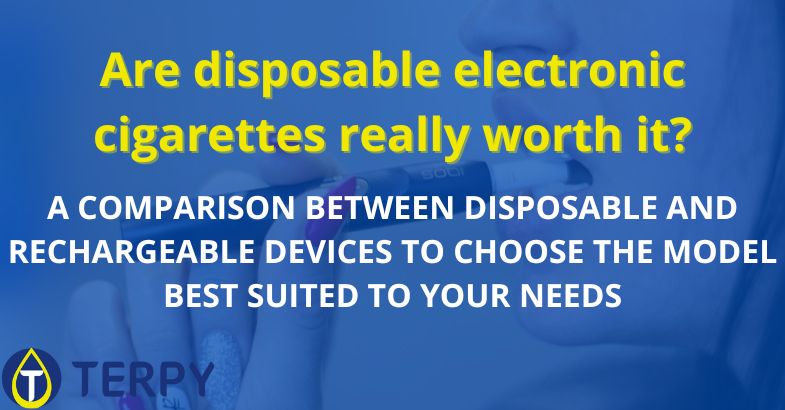Modified on: 24/05/2024
A COMPARISON BETWEEN DISPOSABLE AND RECHARGEABLE DEVICES TO CHOOSE THE MODEL BEST SUITED TO YOUR NEEDS
The choice between disposable and rechargeable e-cigarettes has become a central issue for users of vaping devices. This article aims to provide a detailed and unbiased analysis, comparing these two product categories in terms of functionality, economics, user experience and environmental impact.
Our comparison aims to raise important questions not only about the personal experience of vaping, but also about the long-term economic and environmental implications of these choices. With the aim of providing comprehensive and up-to-date information, we will analyze the topic in depth, helping readers to better understand the differences and similarities between these two categories of e-cigarettes , and to make an informed choice based on their personal needs and preferences.
The main differences between disposable e-cigarettes and rechargeable devices
When comparing disposable and rechargeable electronic cigarettes, a fundamental distinction emerges in their construction and functional characteristics .
Let’s start with the first, which are presented as disposable devices, pre-loaded with a vaporizing liquid that may or may not contain nicotine. Their internal structure consists of a battery, a resistor and a tank, all well welded together. One of the characteristics of these devices, in fact, is the impossibility of dismantling any component. They do not require any maintenance, and once exhausted they must be disposed of in their entirety as technological waste.
In contrast, rechargeable e-cigarettes, whether box mods or other models, are designed for extended use . They feature separable and replaceable components, such as rechargeable tanks, replaceable batteries and interchangeable resistors. This modularity allows for a more personalized vaping experience, allowing users to choose between different e-cigarette liquids and adjust the intensity of the vapor. However, they require regular maintenance, including cleaning the components and periodically replacing the resistor and battery.
Both types of devices operate through a mechanism by which a heating element (the metal coil) vaporizes the flavored liquid to produce, precisely, vapor. This process differs from burning traditional tobacco , offering a smoke-free experience and reducing the production of toxic substances.
Read also: The most common vaping mistakes (and how to avoid them)


Pros and cons of disposable e-cigarettes versus rechargeable ones
By exploring the advantages and disadvantages of disposable versus rechargeable e-cigarettes, crucial considerations for users emerge.
Let’s look at them quickly in this paragraph and then delve into the most important ones in the rest of the article.
The advantages of disposable e-cigarettes mainly lie in their ease of use and accessibility . They are ready-to-use devices, without any need for maintenance or charging, making them ideal for those approaching vaping for the first time or for those looking for a quick, no-obligation solution
However, their disadvantages manifest themselves mainly in terms of environmental impact and long-term costs . In fact, their very disposable nature contributes to an increase in technological waste, and their disposal requires a lot of attention to avoid environmental damage.
In economic terms, although they are convenient in the short term compared to the price of a rechargeable device, repeat purchases can be more expensive over time .
On the other hand, rechargeable e-cigarettes offer the advantage of sustainability and customization. The ability to recharge the battery and fill the tank with different e-cig liquids gives users greater control over the vaping experience and reduces waste. Furthermore, the wide choice of resistances allows you to customize the intensity and taste of the vapor. Economically, although they have a higher initial cost, they are more convenient in the long run thanks to their durability and the possibility of recharging and replacing the components.
Their disadvantages include a steeper learning curve for new users, given the need for maintenance and the complexity of filling and replacing parts. Furthermore, regular maintenance requires constant effort to ensure the correct functioning of the device.
Generally speaking, the choice between the two types of devices depends on individual needs and preferences . While disposable e-cigarettes offer convenience and simplicity, rechargeable ones stand out for sustainability and customization, outlining a framework of advantages and disadvantages that reflects the diversity of user needs in the world of vaping.
A comparison between the environmental impact of disposable and rechargeable devices
The analysis of the environmental impact of electronic cigarettes reveals crucial facets in the discussion on eco-sustainability.
Disposable devices, while offering convenience and ease of use, present significant environmental concerns. Their single-use nature leads to a significant increase in technological waste. Once used up, these devices must be disposed of as waste electrical and electronic equipment (WEEE) , requiring specific treatment to avoid the release of toxic substances into the environment.
Their diffusion therefore contributes to an increase in the load on waste management systems , making correct disposal imperative to mitigate the ecological impact.
As for rechargeable electronic cigarettes, their environmental sustainability is evidently greater . The possibility of reuse significantly reduces waste production. However, these devices also have an impact, especially when considering the need to periodically replace components such as batteries and resistors. The production and disposal of these parts has an environmental impact, although less than single-use devices.
It is important to note that both types of devices, if not disposed of correctly, can contribute to environmental pollution. Batteries, electronic components and plastic materials require appropriate treatment to avoid damage to the environment.
All the factors to be taken into consideration for an accurate analysis of the economic convenience of electronic cigarettes
Even from an economic point of view, the differences between disposable electronic cigarettes compared to rechargeable ones play a decisive role in consumer choice.
The initial attractiveness of the former lies precisely in their relatively low cost per unit , generally oscillating between 5 and 10 euros. This immediate convenience makes them convenient options at first glance for consumers looking for a quick, no-obligation solution. However, this initial advantage may prove illusory in the long run: the repeated purchase of disposable devices can prove to be a significant cost, especially for heavy users.
On the contrary, rechargeable electronic cigarettes, despite having a higher initial cost due to the purchase of the model, components and necessary accessories, prove to be cheaper in the long term .


The possibility of reusing the same device , refilling the tank with electronic cigarette liquids purchased separately and replacing components such as resistors and batteries, reduces the overall expense. This spending model, spread over time, results in substantial savings for regular users.
It is also important to consider the added value offered by rechargeable devices in terms of customizing the vaping experience , which can justify their initially higher price. The choice between a large variety of e-cigarette liquids and the ability to tailor vaping to individual preferences offer value that goes beyond simple cost comparison.
Furthermore, it should not be forgotten that in terms of vaping quality, rechargeable electronic cigarettes tend to offer greater consistency and intensity of vapor , thanks to their more advanced technology and the possibility of choosing particular components. For this reason, for more experienced users or those looking for a more intense and varied vaping experience, rechargeable e-cigarettes are often the preferred choice.
In short, from this point of view we can conclude that while disposable e-cigarettes may seem more convenient at first glance, a more in-depth look reveals that rechargeable models offer greater savings in the long term, together with additional benefits in terms of customization. and variety of vaping experiences . These considerations play a fundamental role in the purchasing decision, guiding consumers towards choices that balance initial costs and long-term benefits.
Read also: Everything you need to know about the effects of nicotine
In conclusion
Comparing disposable and rechargeable e-cigarettes reveals a complex landscape, where each type has its own strengths and limitations .
Disposables stand out for their out-of-the-box convenience, ease of use and accessibility, making them an attractive choice for newbies or those looking for a practical, immediate solution. However, their cumulative costs and long-term environmental impacts are critical aspects to consider.
On the other hand, rechargeable e-cigarettes offer a more sustainable and customizable solution . Despite the higher initial cost and the need for regular maintenance, these cigarettes represent a cost-effective long-term investment, with a reduced environmental impact and greater customization of the vaping experience.
In this context, the choice between the two types depends on a number of personal factors : frequency of use, interest in customizing the vaping experience, long-term economic considerations and environmental awareness. It’s clear that while some people may prefer the convenience and simplicity of disposable cigarettes, others may lean towards the more sustainable and personalized approach of refillable cigarettes.
Ultimately, both disposable and rechargeable e-cigarettes have a role to play in the vaping landscape, each meeting different needs and preferences. Understanding these differences is fundamental to balanced and informed information, allowing users to make informed choices based on their individual needs and impact on the environment.
You should now have all the information you need to choose the ideal device for you . If you’re ready, take a look at the e-cigarettes available on our Terpy shop .
And don’t forget to purchase all the other products you will need to enjoy your vaping sessions: on Terpy you will find numerous e-cigarette liquids for all tastes or, if you prefer do-it-yourself, everything you need to mix them at home, such as concentrated flavors and nicotine shots .
Take Aways
- Disposable e-cigarettes are pre-charged single-use devices, while rechargeable ones are designed for extended use and offer modularity and customization.
- Disposable cigarettes are easy to use and affordable, ideal for beginners or those looking for a no-obligation solution. However, they have disadvantages in terms of environmental impact and long-term costs.
- Rechargeable e-cigarettes are more sustainable and allow for greater customization. Although they have a higher initial cost, they offer significant savings over time and better vaping quality.
- Disposable cigarettes contribute to the increase in technological waste, while refillable cigarettes are more sustainable thanks to the possibility of reuse.
- Disposable e-cigarettes may seem convenient in the short term, but refillables are more advantageous in the long run, taking into account the overall costs and additional benefits.
Questions and answers
What are the main differences between disposable e-cigarettes and rechargeable devices?
Key differences include the single-use nature of disposable e-cigarettes, which cannot be disassembled or recharged, while rechargeable devices allow for the replacement of tanks, batteries and coils, allowing for greater customization of the vaping experience.
What is the environmental impact of disposable devices compared to rechargeable ones?
Disposable e-cigarettes contribute to an increase in technological waste, while rechargeable ones reduce the environmental impact thanks to the possibility of reuse. However, both types can contribute to pollution if disposed of improperly.
Are disposable cigarettes or refillable cigarettes more economically advantageous?
From an economic perspective, disposable e-cigarettes may seem more convenient in the short term, but in the long run, rechargeable cigarettes are generally cheaper due to the ability to refill and reuse the components.





